|
|
| home |
| Dan
Graham interview Pietro Valle |
||||
| [in italiano] | Pietro
Valle interviews Dan Graham at his studio in New York. The American
artist speaks about the various themes he has explored throughout his
career: inter-subjectivity, the mirror and the double, time delay in
videos and performances, the relations between subject and object in
space, glass buildings, the alternation between transparency and reflection
in his pavilions, allegory seen through architecture, control systems,
ephemeral forms of communication and rock music. A thorough analysis
of a restless testifier of modern times. |
|||
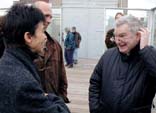 Dan Graham. Dia Art Foundation, 2000. |
PIETRO
VALLE: Let's start with the theme of the transparency/reflection duality
in your pavilions, the scattering of the boundary between observer and
observed, a topic that is present also in your videos and performances. DAN GRAHAM: I'm interested in inter-subjectivity, exploring how a person, in a precise and given moment, perceives him/herself while at the same time watching other people who in turn are watching him/her. When I was fourteen, I read Jean Paul Sartre's book Being and Nothingness and I realized how, when we are young, we develop the notion of Ego the moment we feel that someone is watching us. As a young man, for a short period of time I was the manager of the John Daniels art gallery where, at the beginning of the Sixties, I exhibited some of the early experimental works of Minimalism. The general opinion about that from of art at that time was that it was based on objective relations and therefore, to contrast that idea, I decided that my productions would highlight the spectator's subjective point of view. On top of that, I was interested in the relation between group perception and the perception of the individual spectator, the one who had time to ponder. But you didn't start working on these relations through environmental productions but through videos and performances. |
[15may2002] | ||
|
I started with the videos because, when I was teaching at the Nova Scotia
College of Art, students could afford this type of equipment quite easily
and also, at the time when video art developed, shooting events was
a practice envisaged in many curricula such as, for example, in the
faculties of psychology. I was very interested in the group therapies
that psychologists were experimenting with towards the end of the Seventies,
such as Instant Karma or Primal Scream. When I was at Nova Scotia,
I produced a work entitled Two Consciousness Projection(s), featuring
a monitor, a woman sitting watching the monitor and a man behind the
monitor using a camera to film the woman. The man watched the woman
through the camera; the woman watched her own image on the monitor.
I asked both of them to simultaneously describe to the public attending
the performance what they saw. The spectators perceived that the woman,
who was trying to relate with her image, described a situation that
was much closer to reality compared with the man who had to deal with
an objective presence placed in front of him. By creating a field of
asymmetric interferences, this experiment aimed at questioning the common
place whereby two persons, when they meet, project their consciousness
on each other. When did you start considering the mirror? First through Structuralism. I had taken an interest in Levi-Strauss and especially in Sartre and his idea of interpenetration between two egos. Then there was a host of American psychoanalytical studies about the relations between schizophrenia and perception. The duality between transparency/glass and reflection/mirror became a recurrent theme in your work. Was there a precise moment in which you began this study or did it ensue spontaneously from the themes you had previously developed in your performances and videos? When I was working with videos I realized that, because of the time delay between recording and playback and because of the juxtaposition of different spaces, the video replaced what in architecture was the glass of the perspective window of the Renaissance. So I started overlapping video, glass and mirrors. Moreover, the time delay of the video allowed to eliminate the immediateness of the Renaissance perspective window. Was this a way of criticizing the opening of the perspective window of the Renaissance and its hierarchic stance between observer, projection plan and object? |
Dan Graham (Urbana, Illinois, USA 1942) is one of the main figures of the conceptual trend that appeared towards the end of the Sixties in New York. An important retrospective exhibition on Graham's works from 1965 to today is touring Europe and will be in Helsinki in May, after stopping at the Museo de Arte Contemporanea de Serralves in Oporto, the Musée d'Art Moderne de la Ville de Paris and the Kroller-Müller in Otterlo. Apart from participating in various exhibitions in Italy, Dan Graham recently designed a glass pavilion, Bisected Two-Way Mirror Triangle, for collector Egidio Marzona's art meadow in Verzegnis near Udine. | |||
 Bisected two way mirror triangle, 1998. |
Yes, I was trying to move away from the fixed focus, and the vanishing
point. With videos, when you move in space, you don't need to anchor
things to fixed points; with perspective, instead, you do. Moreover,
the time delay is linked to drug-produced hallucinatory conditions where
you re-insert into the present tense what you have just done, moving
in a kind of mental space-time. Later on I took an interest in Walter
Benjamin's theory about recent past time and I tried to relate it to
the present through video. Are you referring to Benjamin's theory about exploring recent cultural events, the one he deals with in the "Arcades Project"? Yes, I'm referring to his interest in the ephemeral events that disappear almost at once and how they affect the present, as in the case of the song by the Rolling Stones Yesterday Papers: "Who wants yesterday's papers?" Benjamin maintains that yesterday's papers are important. Just look around: modern cultural expressions contain a host of revivals, the new Fifties, the new Seventies, where we forget completely the years we live in. 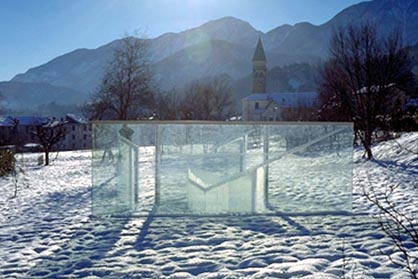 Bisected two way mirror triangle, 1998. What do you think about Benjamin's theory about the shop windows of the Paris passages, where the spectator's reflected image overlaps the image of the items on display, thus creating identification? I'm very interested in this idea. When I produced Public Space/Two Audiences for Arte-Ambiente in Venice in 1976, I realized that the Biennale worked like the universal exhibitions of the 19th century: there are different countries and one pavilion for each country to exhibit the works of its two or three major artists. Instead of commodities, in this case it was the world of art that was the commodity on display. What I wanted to do was to put the spectator in the place of the commodity, so I created a rectangular room and divided it into two spaces by means of a soundproof glass wall. The wall in the back of one of the two halves was a mirror, while in the other half there was a normal white wall. When a person walked into the room and was alone, it was like being inside a form of Minimalist art; but when there were other persons in the room, the public on one side of the glass wall became the reflected image of the public on the other side. Those entering the half room with the mirror wall could turn around to look at the wall and see themselves as they interacted at once both with the persons who were in their half of the room and with those who were in the other half; or, they could turn around and look at the persons through the glass wall in the direction of the white wall without seeing their own reflected image. The people in the room with the white wall looked mainly at the mirror, seeing themselves reflected far away, beyond those who were in the room on the other side of the glass wall. However, those who were in the room with the white wall also saw the ghostly reflected image that the glass wall produced, creating a double mirrored image and a feeling of loss that was generated by the continuous reversal between observers and the observed. I also realized that this mechanism would have worked wonderfully in Venice because Italians are very rhetorical people and therefore, the two groups of people, who were acoustically isolated, would have tried to communicate visually by making signs and waving. So, public space is used for social performance purposes. |
|||
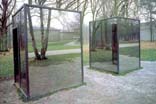 Two adjacent pavilions, 1978-81. |
Precisely! Later on I designed pavilions that were made totally out
of reflective glass because I felt that this work of art was too simple,
it was like a stage setting and the wall was too similar to the neutral
"white cube" that is normally used in museums. So I decided to get rid
of the wall and to turn it into an open window. Public Space/Two Audiences had only one threshold, one interface, while the two-way mirror pavilions had more than one. I wanted to integrate the external space into the visual dialogue and, by getting rid of the wall, I created Alterations to a Suburban House and the first Two-Way Mirror Pavilions, in an attempt to project myself into the surrounding landscape. In many of your pavilions you used angles that are not orthogonal with the various faces, so that the mirror or opening effects are absolutely unpredictable. Spectators are at loss, never knowing if they will see their image or someone else's. What are the reasons for this strategy of spatial displacement? Has it always been there or is it something that you developed only recently? Topology was one of the main topics of interest among the artists who preceded Minimalism at the end of the Sixties and I myself was influenced by it in my early videos and performances. I was attracted by the continuity between opposites, the idea of a Moebius strip-like condition. For instance, I produced a video entitled Past Future Split Attention where two people meeting each other were given instructions: one could only foresee the future of the other while the latter, at the same time, had to tell about the past of the person facing him. If one foresaw something negative about the other, the latter would probably relate very unpleasant things about the past of the former and so they were both indissolubly bound together in a continuous loop made up of past, present and future. This is what happened with time while in my pavilions I started using curved and anamorphic shapes, trying to turn Minimalist space into Baroque space. In my research, I started finding an interest also in corporate office buildings. My work imitates and at the same time criticizes the use of curtain-walls in corporate skyscrapers. In the Nineties, the facades of these buildings gradually became more elliptical, moving closer to a Baroque-like sensibility. |
|||
| In
your writings of the Seventies, you were among the first authors to
point out how the transparency of curtain-walls in International Style
skyscrapers is a rhetorical apparatus. You stated that their apparent
visual opening actually hides the opaqueness of the mechanisms of power
that are concealed behind the facades, thus generating different gazes
between those who are watching from outside and those who are hiding
inside. I believe I was influenced by Robert Venturi's attack against Mies van der Rohe's aesthetics of the time. However, the more I investigated the reasons for this critical approach, the more I appreciated the beauty of Mies's viewpoint. So I tried to get Mies and Venturi, two opposites, to interact. Alterations to a Suburban House is a combination between Farnsworth House and the curving of the facade towards the nearby buildings that we find in Venturi's early projects, as well as the use he makes of the single-family suburban house. 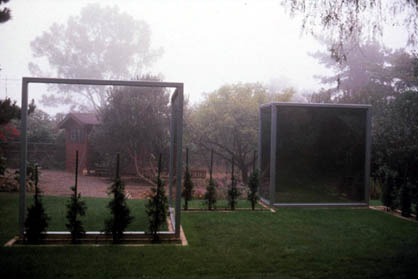 Two way mirror hedge labyrinth, 1991. You also produced a work entitled Video Projections Outside Home where you juxtaposed a suburban home with an enormous video screen projecting on the street what was being watched on TV inside the home. What do you think about the interaction between architecture and video? Usually it appears in the form of closed-circuit cameras in different kinds of public spaces. Video-based surveillance became very important in the Eighties in the halls and covered plazas of corporate buildings, where idyllic Arcadian landscapes enclosed in greenhouses and controlled by means of cameras were often created. The idea was to make downtown areas as safe as suburban neighborhoods and the way to achieve this goal was to use a hidden network of watchdogs, which was the closet-circuit system. Apart from winter gardens, at the end of the Seventies major corporations and financial companies started using two-way mirror glass (reflective on one side and transparent on the other) in their curtain-walls and they did so because, by reflecting the sky, they were trying to relate with ecology at a time when they were the very ones being accused of destroying nature. All of which actually created a situation of visual control so that those who were inside the building could keep an eye without being seen on those who were outside while those who were in the street could only see their reflected image. This change totally replaced Mies's transparency with one-way opaqueness. In this sense my pavilions are utopian because both transparency and the reflection can be seen at once from both sides of the wall. I use the type of two-way mirror glass that allows to calculate the percentage of reflection on both sides and I keep a low level of reflection so that I can mix it with the transparency. But the ratio between the two depends also on the external lighting and sky conditions; as a matter of fact, it changes continuously and this makes my architectural productions take up a landscape-like condition. Mies's Barcelona Pavilion does something very similar to this, it is a landscape analogy. Mies refers to the English garden picturesque tradition, to an ever-changing path. When you walk inside the pavilion, you see your own image reflected in the shiny stone slabs, in the glass surfaces, in the pool water. |
||||
 Bisected two way mirror triangle, 1998. |
IYou
seem to be more and more interested in landscapes. However, there's
a difference between landscaping, i.e. the production of specialized
areas in the suburban culture (often segregating buffer zones), and
the landscape that you try to unveil with your pavilions. In my Two-Way Mirror Hedge Labyrinth I combine the hedges that are typical of Baroque garden labyrinths with the glass that is typically used for corporate buildings. That specific pavilion was built for the home of a collector and the hedge is the extension of the fence of the existing garden. Hedges have become a means to mark the boundary between public and private in the single-family residential culture. I try to mix urban greenery elements with elements taken from the corporate areas but in a different way compared with the halls in skyscrapers where the greenery is imprisoned inside the building. What do you think about the English picturesque tradition as opposed to the Baroque one? The English garden was a philosophical and political allegory. When I first started building landscape structures with Two Adjacent Pavilions, I was interested in the philosophical allegory: the two pavilions were like two egos reflecting each other. They had been built for Documenta in Kassel and they related to the Baroque building complex hosting the exhibition. I had referred them to Amalienburg, the pavilion Francois Cuvilliés had built in Munich in the Nymphenburg complex. The most interesting part of this hunting lodge was the mirrors room, where the windows projected the outdoor scene onto indoor mirrors, thus multiplying both settings. The mirrors were decorated with silver embossed leaves. When the king arrived, the windows were opened and the sunlight tinted them into a golden glitter. This symbolized the king's alchemical ability to turn silver into gold. Likewise, the mirror facades of the skyscrapers turn the glass into a picture of the sky. Both are representations of power and I am particularly interested in such forms of allegory. Recent architecture seems to have re-discovered Conceptual and Post-Minimalist Art. What do you think about those who adapt the ideas and themes of that period? |
|||
|
Rem Koolhaas uses two-way mirror glass and time delay cameras for the
dressing rooms in his Prada shop on Broadway. What he's doing is a theme
park of the art of the Eighties reduced to interior decoration. He turns
everything into a theme, just like Disney does. He is very much like
Philip Johnson in this: he creates facades for the economic power, drawing
upon ideas belonging to different contexts and authors. He is the perfect
capitalistic architect, much more clever than Johnson but equally interested
in power. Instead, some recent forms of art refer to architecture. I don't see much of that. Perhaps I'm more interested in current architecture than artists referencing architecture. Among the contemporary designers, who has impressed you mostly? I find Shigeru Ban's works very interesting, especially the way in which he re-proposes an ecological dimension in architecture. He deals with reclaiming degraded areas, integrating nature into urban homes. There are some references to Emilio Ambasz's early works, but while the latter created a post-Superstudio performance, Ban is an architect who actually builds. I also like Itsuko Hasegawa's works: she calls herself a landscape designer although she uses industrial material to create her landscapes. What about the use of computers in recent architecture? I think that computer-generated architecture is superficial and far from reality. Everyone's concerned with images or, in the case of structures that are built, with the fact that they should appear beautiful on the pages of magazines. When I designed the catalogue for my pavilion at the Dia Art Foundation, I chose to produce a video instead of pictures. Apart from showing ever-changing points of view, the video told about New York in the Seventies and Eighties because the pavilion at the Dia combines elements that are drawn from both decades, the early alternative spaces and the lobbies in financial centers. I wanted to integrate these two periods as if already passed - as Benjamin would have viewed them - and so the video spoke about New York's recent past. On top of that, the Dia pavilion, Two-Way Mirror Cylinder Inside Cube, relates the orthogonal urban grid of New York with the rooftop space of the water towers, the corporeal perception of the people walking in the streets, the line of the horizon and the skyline.  Two way mirror cylinder inside cube, 1991. When you published Homes for America in 1966, you were one of the first persons to focus on suburban spaces, on the invisible, discarded non-places; recently, these themes have drawn the attention of many architects and town-planners. What did you have in mind at that time and what do you think of it now in hindsight? I grew up in New Jersey and I have always been interested in serial settlements. When I was at the John Daniels Gallery, I was one of the first to organize an exhibition of Sol LeWitt's works and I realized that Sol was (re)making New York's orthogonal grid. At that time he used to work for I.M. Pei and so he stressed the modern architect's notion of geometry in art. During that same period, I happened to read in Arts Magazine an article by Donald Judd about the urban structure of Kansas City, which was based on a plan of the 19th century. Then Judd moved to New Jersey and I realized that he too used the material of the suburban facades as well as procedures drawn from urban analysis. So I said why not photograph all of this, the suburbia, the real original material. In 1966 I was also reading Michel Butor's La Modification, the masterpiece of the French Nouveau Roman, which spoke about cities as labyrinths. All of this was much more interesting than the white cube used in galleries and I realized that I could establish a relation between art and town and suburb planning. Here lies the secret of Minimalist art, the secret that is never told and that was suppressed by its very authors: the city grid. Establishing a relation with the urban structure is also the secret to good architecture. Tafuri has written a sharp critical essay about the single building standing alone, like a utopia as opposed to all other forms of architecture, and its eventually becoming a commodity.  Two way mirror cylinder inside cube, 1991. Recently, have you focused mainly on pavilions or have you been working at some other form of artistic intervention? |
 Yin-Yang, 1997. |
|||
|
I designed two swimming pools recently. One will be built in one of
Steven Holl's buildings, a dormitory at the Massachusetts Institute
of Technology: I named it Yin/Yang and its female portion, Yin,
is a water surface while its male portion, Yang, is an expanse of white
gravel, like a Zen garden without the stones. An S-shaped curved glass
wall, the Yin/Yang symbol, separates the two areas and the whole structure
is to be viewed as a parody of the New Age. The curved glass walls will
create some incredible visual effects; there will be two windows of
this kind: the semicircular wall around the gravel area and the serpentine-shaped
dividing wall I just mentioned. You can access the fenced-in area between
the two curved walls and walk on the gravel, to be surrounded both indoors
and outdoors by anamorphic effects. I also designed Swimming Pool/Fish
Pond, a swimming pool integrated with an aquarium. There is a circular
enclosure and a curved wall, both made out of mirror glass. The curved
wall separates the larger swimming area from the smaller fishpond area.
A slanted wooden ramp allows swimmers to reach the edge of the pool
and the diving-board: below the ramp is a coffee-shop where spectators
can look through the glass and superimpose the swimmers, the fish and
their own images reflected by the convex dividing wall. Apart from architecture, do you still make videos? |
||||
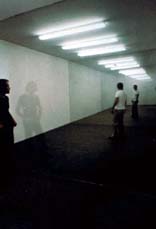 Public space-2 audiences, 1976. |
The technologies today are too costly. I used to make videos when I
could create the time delay using analogical equipment to work on the
tapes. With the advent of digital equipment, everything has become precious
and specialized. I enjoyed making videos when it was still a new and
amateur form of art: as a matter of fact, I felt more like an amateur
artist than a real professional. The type of immediateness that could be achieved with the early cameras, the ones that were used for home videos, produced a liberating effect among many artists of the Sixties. Today, video making has again become an exclusive form of art because it is totally manipulated by post-production. It deals with the spectacle; the artist, instead of producing the performance, should deconstruct it. Let's talk about your interest in popular music. As a reviewer you wrote essays about a great number of different topics ranging from Dean Martin to Country, from Punk to New Wave. What has all of this to do with visual and social research? |
|||
|
When I used to write reviews in commercial magazines, I was interested
in the spontaneous forms of communication that had to do with clichés
and could be discarded after they had been used: short forms, pop forms. Is this how you happened to approach pop music? Music affects your mind: Sol LeWitt was interested in classical music, I got ideas listening to the Kinks and to Rock 'n' Roll but also to music by composers such as Steve Reich and Terry Riley. What do you think of Minimalist music? |
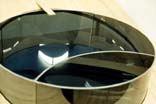 Swimming pool-fish pond, 1997. |
|||
|
Steve Reich was one of the first musicians to use time delay in music:
he developed some of Terry Riley's ideas using some very simple mechanical
means to obtain effects such as phasing, time delayed recordings. What
I like about Steve and La Monte Young's early productions is that they
establish a relation between sound, the spectator's perception and the
architectural environment: they were situation-makers. Pendulum Music,
Steve's piece of music with the microphones swinging from the ceiling,
was very important but also La Monte Young used to create sound signals
related to the walls: the feeling was that of being at the same time
inside the architecture and inside your own mind. The early Minimalists
wanted to establish a relation between the body's internal time, the
mind and the environment. How is all of this related to rock music? There's a type of rock production in New York that was greatly influenced by Steve Reich: The Feelies, Television, Sonic Youth. The repetitive structure and the time delays are very similar, there are no big differences. In two hours I'll be meeting Kim Gordon, the Sonic Youth bass guitarist. I like her articles and I want us to meet so that I can tell her how to convey her ideas through writing. Kim wrote some of the best reviews about the new art before joining Sonic Youth. She published in Artforum the first reviews written by artists such as Mike Kelley, Raymond Pettibon, Tony Oursler, Jeff Wall and Glenn Branca. Are these works collected in a single book? No, they are published in various magazines. Perhaps you could make a collection. I have no power but they, Sonic Youth, they do: they have the power of success. |
||||
| Si ringrazia per la traduzione The Office, Trieste. | ||||
| > ARTLAND | ||||